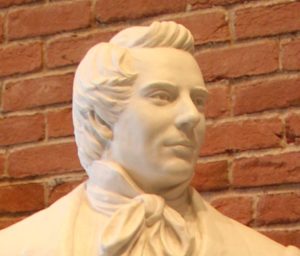 Joseph Smith simply said that The Book of Mormon was translated, “by the gift and power of God” and for the first fifty or so years of my life that was good enough for me. I didn’t give much thought to the process and was satisfied with just trying to read and understand it. Then a couple of years ago I had an experience that I’ve since discovered wasn’t unique.
Joseph Smith simply said that The Book of Mormon was translated, “by the gift and power of God” and for the first fifty or so years of my life that was good enough for me. I didn’t give much thought to the process and was satisfied with just trying to read and understand it. Then a couple of years ago I had an experience that I’ve since discovered wasn’t unique.
The Book of Mormon Musical was coming to Salt Lake City. I knew that it was a big hit on Broadway, but didn’t know much more about it. So one afternoon I turned to the internet to satisfy my curiosity. One link led to another and I ended up watching part of a South Park episode which showed Joseph Smith translating The Book of Mormon by putting his face into a hat while the music kept repeating dumb, dumb, dumb, dumb, dumb. I was offended and remember thinking that if they were going to be insulting they should at least get it right, and do enough research to know that Joseph Smith used the Urim and Thummim, not a rock in a hat.
It was just a few months later that the church published a picture of the seer stone in the Ensign magazine. I was completely underwhelmed. First of all, I realized that South Park knew what I—a life-long member of the church—didn’t, but that wasn’t the biggest disappointment for me. The biggest letdown was the stone itself; it was a pretty unimpressive brown rock.
I had a narrative of my own invention that featured an all-knowing, and therefore high-tech capable, God. The Liahona, which had seemed miraculous to me in the 60’s, now seemed to have fewer features than my I-phone. Why couldn’t God drop Lehi some sort of GPS communication device, and following the same pattern give an interpretation device to Joseph Smith to translate the plates?
The Urim and Thummim of my imagination didn’t reconcile well with the stone in picture, but it certainly didn’t throw my testimony for a loop. In fact, it didn’t have much impact on me at all. I just went on believing and trying to read and heed The Book of Mormon.
 It was only recently that I recognized that others had processed this in an entirely different way, asking themselves why the church had deceived them and what else the church was hiding from them.
It was only recently that I recognized that others had processed this in an entirely different way, asking themselves why the church had deceived them and what else the church was hiding from them.
In all fairness, there are definitely two compelling sides to this argument. You certainly could—and I did—live your whole life as an active, seminary and institute attending member of the church and never hear that The Book of Mormon was translated with Joseph’s face in a hat and the golden plates not even in sight. This certainly isn’t the way that church art depicted the process. The art we all saw usually had Joseph intently studying the plates spread on the table before him.
Being equally fair, information about the stones has always been available to anyone willing to do as much homework as South Park had. Had I ever questioned why the art showed Joseph reading the plates, when the story I accepted involved spectacles and a breastplate? No. It never mattered to me, but if I had, there were Ensign articles, an essay on LDS.org, and plenty of books and other sources that would have provided the seer stone version of the translation.
Once I realized that others were thrown by the seer stone, I took time to study and process the new information. Here’s what I have so far:
- The art is misleading, but it is art and subject to the artist’s interpretation. I recently listened to a podcast with Anthony Sweat, who has been producing some updated art. He talks about the difficulties of portraying Joseph with his head in his hat without making it look like he is suffering from stomach problems. I think artists also chose to leave the spectacles out of the picture because they were more concerned with conveying a feeling than accurate history. I’ve seen several well done depictions with the hat, and I believe and hope we will be seeing more in the future.
- While the narrative most of us learned was less than totally correct, I believe there are reasonable explanations for this. Joseph Smith chose not to describe the translation process in detail, possibly preferring to put the focus on the content of the text rather than its origin. Also, he seems to have used the terms, Urim and Thummim, interpreters, and seer stones interchangeably. Over time, since Urim and Thummim was the biblical term, it became the mostly commonly used, even though both the seer stones and the Nephite interpreters differed somewhat from the traditional Hebrew stones. Adding to the confusion, is the fact that there were few written accounts of the translation and they sometimes contradicted each other, making it even more difficult to know exactly what method of revelation Joseph used at any given time. It appears that Joseph initially used the interpreters that he received with the plates, but later found that the seer stone was as effective and more convenient.
- The recent scholarship connected to the Joseph Smith Papers Project, and cooperative efforts with the Community of Christ, have produced and made available more information than ever before. Unfortunately, as the church becomes more transparent, they also draw criticism for not having disclosed more in the past. I feel confident that it is just a matter of time before members of the church are taught and embrace all the truth that is available about the coming forth of The Book of Mormon.
- Once processed, the seer stone in the hat story feels better to me than my previous ideas. Let’s be honest; why would two stones on a breastplate be preferable to one stone in a hat? Both require a belief in the miraculous, and that plain ordinary-looking stone excludes the possibility of a technical explanation, while the hat suggests the need to eliminate the distractions of the world as we seek for light and knowledge. I like this emphasis, not on the ancient relic—which none of us have—but on the inspiration—which we can all seek. This new history seems to show the Lord using things that Joseph already understood, meeting him where he was, and leading him step by step, as he built the confidence and learned the process of revelation that was needed to accomplish the restoration. The seer stones reveal a connection that early church members felt between the material and spiritual that we may benefit from reexamining.
It is hard to explain, but exploring the seer stones and discovering so much new information, has somehow left me with new questions that I don’t yet have answers for.
- Why do people have such different reactions to the same evidence?
- What does my reaction say about me? Could it be the gift of testimony, or am I just a blind follower?
- Why did I have so little interest until my beliefs were challenged, and what other questions am I failing to ask?
- What am I still missing? Certainly there are still connections between the spiritual and the physical worlds that I’m only beginning to understand.
As a teenager I received my patriarchal blessing, which I honestly found to be a little disappointing. It was fairly short and where it was specific, it didn’t necessarily tell me what I wanted to hear. One line that has always bothered me said, “It shall not be hard for you to stand before others and tell them of your faith.” Unfortunately, all my life speaking about my faith has been hard. My testimony is strong, but I have never felt knowledgeable enough to speak boldly. I chose the name justjanasue because it admits that I’m not an expert; I’m not yet even particularly well read. There are stronger sources for learning about gospel topics. This is just my testimony that the deeper I dig into the gospel, the more truth I find.
Recent Comments